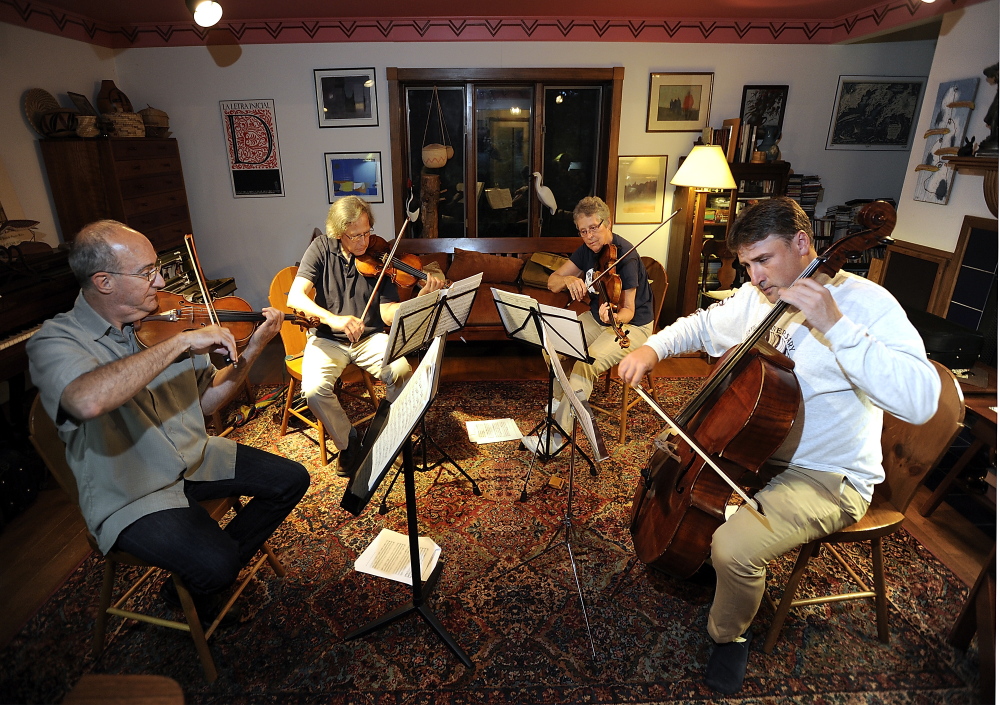Now in its 47th year, the Portland String Quartet can rightly be called venerable, although in a sense, it is also brand new. When a chamber group takes on a new member, as this quartet has done twice since 2012, its chemistry can change significantly. In theory, the newcomer should adapt to the traditions and practices of the existing group. But musicmaking doesn’t work that way. In the normal push and pull of rehearsals and performances, a new player coming to the process with different experiences is likely to contribute interpretive ideas that might otherwise not have been considered.
The Portland String Quartet had a steady roster from 1969 until 2012, when Steve Kecskemethy, its founding first violinist, fell ill and left the group. Dean Stein replaced him, but last season Paul Ross, the quartet’s cellist, announced his retirement, leaving only Ronald Lantz, second violinist, and Julia Adams, violist, from the original lineup. So when the quartet played its first concert of the season on Sunday afternoon at Woodfords Congregational Church, introducing its new cellist, Patrick Owen, was high on its agenda.
The program was built for the purpose. It began with Mozart’s String Quartet No. 23 in F (K. 590), a late work in which the cello line is nearly as prominent as the first violin line. Often, the two are in dialogue, with the second violin and viola treading water in nearly static accompanying figures. And even in the more fully democratic passages, the cello is consistently at the heart of the action.
Owen seems a good fit for the group. His tone matches the warmth that his colleagues bring to their work. Even when he held the spotlight, in his phrasing and projection he was a part of the collective and working toward a unified conception of Mozart’s score.
One could quibble about exactly what that conception was. Often, the performance was relaxed and gracious, even when the music seemed to cry out for sharper accents, more driven tempos and, above all, greater tension – as if the music were simmering when it was meant to boil.
Granted, this was Mozart at his most courtly and polite: The work was probably composed in the hope of charming King Friedrich Wilhelm III, of Prussia, who was a fine cellist. And lovely, anxiety-free playing is, of course, a legitimate approach. But courtliness need not preclude vividness or energy. You want to be on the edge of your seat, hearing this music, but that only happens if the musicians are. It was not until the brisk finale that the players kicked into high gear.
Perhaps Stein, Lantz and Adams had deliberately throttled down to let Owen shine, but his playing suggested that he would have anyway. In any case, the rest of the program showed that the group’s easygoing approach in the Mozart was not necessarily an inherent part of its style.
Norman Dello Joio’s “Lyrical Interludes,” commissioned by the quartet in 1998, to celebrate its 30th anniversary, is a fantasy in three movements on a children’s piece by Prokofiev, “A Fairy Story” (Op. 65, No. 3). As a prelude to the Dello Joio, Laura Kargul, the director of piano studies at the University of Southern Maine, gave a graceful reading of the little keyboard piece. You could hear shards of the Prokofiev, deconstructed and rebuilt in varied form, throughout the “Lyrical Interludes,” a conservative work that revels in melody and lush harmonies. Its textures are often dense, but rarely dark. But the tension that was missing from the Mozart was fully evident here, as was a striking rhythmic fluidity that let the piece breathe.
Both here and in Ravel’s String Quartet in F (1903), which closed the program, the ensemble’s four instruments are meant to project as equals, and though it was tempting, nevertheless, to focus on the rookie, that quickly proved pointless. His task, after all, is not to stand apart, but to melt into the group’s sound, and he did that perfectly.
The Ravel, a student work that has become a cornerstone of the modern quartet repertory, is a free-spirited, adventurous score – more adventurous than the Dello Joio, actually – in which surprising modulations and inventive, quickly-morphing approaches to texture create an atmosphere thoroughly different from any quartet written before it. The players produced a tightly woven sound here, with much the same sense of ebb and flow that they brought to the Dello Joio, but with considerably greater heat and light. Any lingering worries about the group’s vitality that the Mozart raised were swept away decisively in the quartet’s powerful account of the Ravel’s gritty finale.
Allan Kozinn is a former music critic and culture writer for The New York Times who lives in Portland. He can be contacted at:
allankozinn@gmail.com
Twitter: kozinn
Send questions/comments to the editors.



Success. Please wait for the page to reload. If the page does not reload within 5 seconds, please refresh the page.
Enter your email and password to access comments.
Hi, to comment on stories you must . This profile is in addition to your subscription and website login.
Already have a commenting profile? .
Invalid username/password.
Please check your email to confirm and complete your registration.
Only subscribers are eligible to post comments. Please subscribe or login first for digital access. Here’s why.
Use the form below to reset your password. When you've submitted your account email, we will send an email with a reset code.